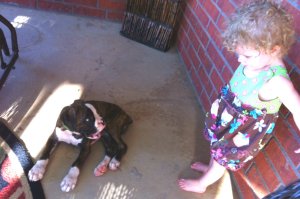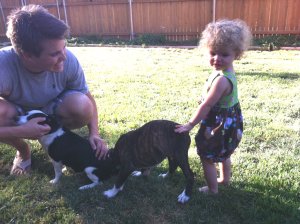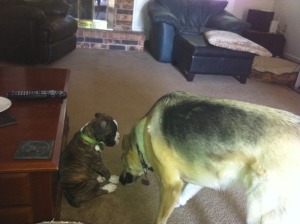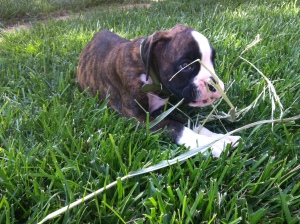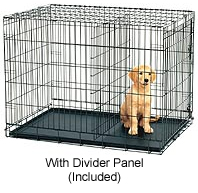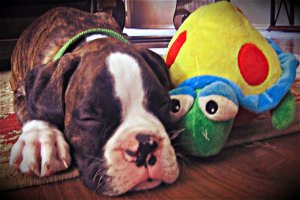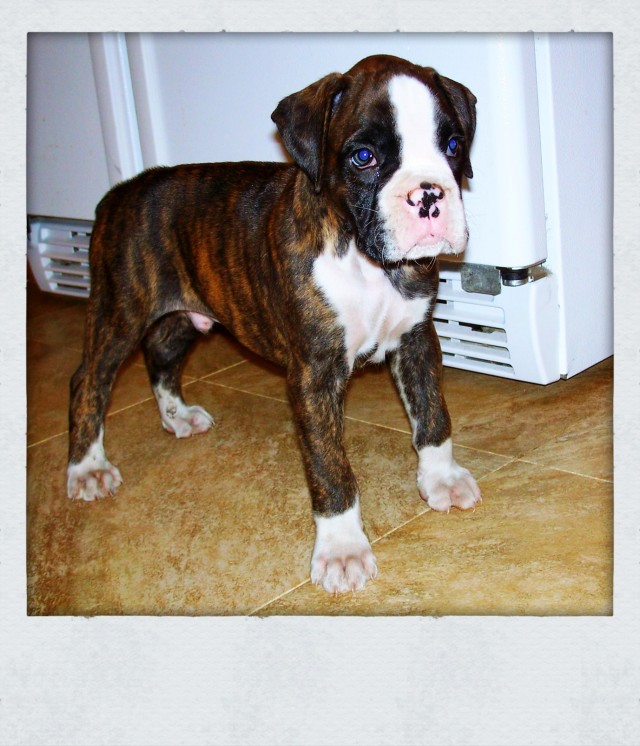Congratulations on bringing your boxer puppy home!
This next week will be full of changes for both you and your new friend. Give him time to adjust to his surroundings and expect to have a few sleepless nights here and there. All worth it though, I promise! You do, after all, now own the clown of the dog world! Very soon you will see what I mean and by the end of the week, after all the laughter you have shared, you might find yourself with some nice washboard abs (wouldn’t that be nice?).
Just like children, puppies are very impressionable at a young age. The events that occur in the next month will greatly determine what type of dog your puppy grows into. It may sound daunting, but after reading the advice below you will be fully prepared to take on this coming week!
1) Make a Vet Appointment Immediately

If you do not already have a vet and do not know of a good one, ask your most responsible pet-owning friends who they see. All vets cost approximately the same, so if someone has incredibly low prices, steer clear! Buying vaccinations from feed stores is also no-no. The employees of such companies rarely know how to properly handle or store these vaccines, so don’t take your changes! Go see a trained professional.
Vaccinating your puppy is a MUST. Without protection, your puppy is susceptible to many life-threatening illnesses. For example, puppies under the age of 20 weeks who contract Parvo, have a death rate of up to 35% precent!
Make sure you have your puppy’s previous vet records from the breeder. Good breeders will provide you with this information, which should include when they were last de-wormed and when they received their first set of DHHP shots. If you didn’t get these records from the breeder, see if they can mail them to you. Your vet will want this information on file as well so go ahead and make copies. Almost all puppies will have had their first round of shots by this age. If yours hasn’t, it is even more imperative to take him to the vet ASAP.
Here is a list of shots your puppy should receive this week (assuming he’s had his first round of shots):
* 4 in 1 vaccine including protection against: Distemper, Hepatitis, Parainfluenza, Parvovirus (DHHP)
* De-worming, the vet may also take a fecal sample.
* Bordatella (if you plan on boarding, kenneling, attending doggie day camps, competitions, etc)
Your vet should also give your puppy his first round of heartworm medication along with flea and tick prevention. These pills should be given exactly a month apart for the rest of his life. Some vets offer heart worm vaccines that protect up to 6 months, but these cannot be administered until a puppy has reached his adult weight.
2) Begin Crate Training
I highly suggest crate training, and have written an article here discussing how to do it correctly. Hope it helps!
Hogan is very content in his crate now!

3) Start Housebreaking
Start on this today! Here is an article with all the details.
4) Establish Household Rules
You need to make these decision early on, as the choices you make will directly affect the type of relationship you will have with your puppy for the rest of his life. Some questions to think about are:
*Where will he sleep? In my room? In my bed? In a separate room?
*Will he be allowed on furniture?
*Are there certain areas of the house that are off-limits?
*How do we expect him to act around house guests?
Once these questions are answered, you need to stick to your guns. Being wishy-washy will only confuse him and frustrate you when he doesn’t obey.
5) Socialization
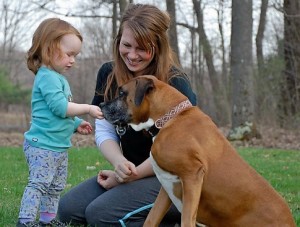
The next four weeks are the most critical time in a puppy’s life for socializing him properly. Though socialization should continue to occur after the 3 month mark, the way he is socialized between 8-12 weeks will play the largest role in his adult temperament.b lop90; It is important that he meets as many new faces as possible ASAP. Introduce him to your neighbor’s kids, your nieces and nephews, every child you can think of. You want your puppy to grow into a docile and patient dog amongst the pulling of ears. Try and check these new acquaintances off your list before he reaches 13 weeks:
* Infants
* Toddlers
* School- aged children
* Elderly, wheelchairs, walkers, etc.
* Men and women
* Friends of ethnic origins
* Large, Medium and Small-Sized, FRIENDLY, VACCINATED Dogs
* Cats (friendly cats! Hogan got scratched by one already and is scared to death.)
* Horses (if you live in a rural area)
* Other farm animals (but like most dog breeds, expect him to try and eat his friend the chicken)

You also want your puppy to be comfortable in common situations and around household objects like the following:
* Crowds of people (think playgrounds, parks, PetsMart). However, until your puppy is fully vaccinated, CARRY your puppy when at these places. These and the like are breeding grounds for Parvo outbreaks. Protect your puppy while still letting him experience new places
* Puppy classes
* Loud or obnoxious noises.
* Vacuum cleaners, dishwashers, blenders, etc.
*Car rides, car-washes
* Swimming pools, lakes, beaches, etc.
You can check out Hogan’s introduction to the pool here: Hogan’s 1st Day at the Pool
For a great checklist of things to introduce your new puppy to each week, click here and scroll to the bottom of the page.
6) Switch Dog Foods
Depending on what type of food your puppy was already eating, you may prefer he eat a more quality brand. I really like Blue Buffalo and highly recommend it. If the breeder didn’t send you home with any food, purhcase a SMALL bag of the brand he is already accustomed to, along with a large bag of what you would like him to eat. SLOWLY transition your puppy into his new food. Simply going from one to the other could cause stomach problems. Follow this schedule:
Day 1 & 2: 75% old 25% new
Day 3 & 4: 50% old 50% new
Day 5 & 6: 25% old 75% new
Day 7: 100% new
Expect to see loose stool this week. If it hasn’t cleared up within 5 days of the final transition, consult your vet.
7) Introduce the Collar and Leash
Your puppy should never be without his collar. Most dogs who are lost without identification never find their homes. Your puppy’s collar should include his name, your address and at least one phone number you can be reached at.
Leash training takes time, this week just focus on getting him familiar with the leash. Attach it to his collar for a few minutes a day and let him walk around with it freely following behind him. Only do this when you can keep an eye on him, you don’t want him strangling himself. Also, attach the leash during meal times so he will begin to associate it with positive experiences. Do not pull him around on the leash, this will only scare him and make leash training that much harder. Focus on the basics this week, we will take the next step in Week 9.
7) Make a Decision on Cropping
If you plan on cropping your puppy’s ears, this needs to be done no later than 12 weeks of age. Consult your vet on what time frame they prefer. Before deciding to crop, make sure you are prepared for the time-consuming effort you will need to put in on top of already raising a new puppy.

Search the internet for pictures of crops you like, and crops you do not like; there are many different styles of cropped ears! Bring these pictures to the vet so they know what you are looking for as a final result.
You shouldn’t necessarily get your puppy’s ears cropped at your vet’s office. Some vets have more experience with boxer ears while others crop more doberman ears. You should pick a vet who is experienced with the boxer breed and can show you the results of past crops.
I am keeping Hogan’s ears natural, I just love the natural look, but that is just my preference! Though natural ears are now accepted in conformation competitions, more often than not boxer’s with cropped ears take home the prize.
***
I hope these tips have given you a lot to do in the next few days! I look forward to sharing with you Hogan’s progress next week and introducing more ways to train your puppy!


